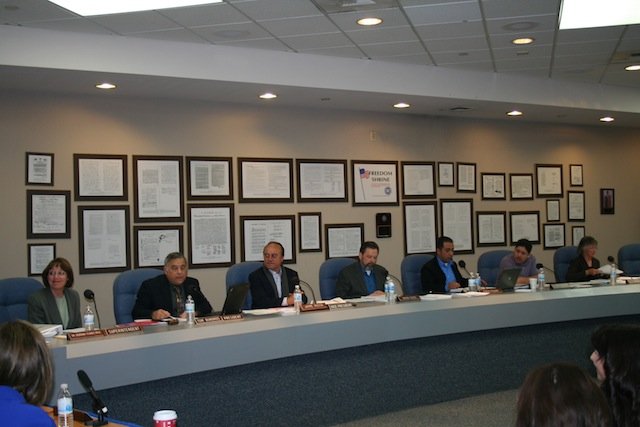A local parcel tax that could help the Gilroy Unified School District stave off future class size increases and salary cuts has branched into three different options: A flat rate parcel tax, a variable rate parcel tax or a joint city/school sales tax.
Asking Gilroy voters to consider a parcel tax – and now possibly a joint city-school sales tax – is being explored by GUSD for the first time as the district braces for a possible $6.9 million cut in its state funding next year. The district has not yet made a motion to put a tax measure on the November ballot.
Prior to discussing the topic in length during a special study session Thursday at district offices, several school board trustees gravitated to the joint city-school sales tax, the most profitable route.
A handful of City Council members are dubious about the feasibility of pulling it off, however.
“We’re two separate elected bodies. They need to manage their own income stream without help from the city,” noted Councilman Bob Dillon, referring to GUSD. “I certainly won’t be voting to do a joint deal with the school district, and on the other two, I wish them luck … but I don’t think there’s a chance in hell.”
The 8.25 percent sales tax in Gilroy, additionally, is already “far too high” and “hurts the auto dealers” who bring in the “big money,” Dillon added. “It’s not that I oppose helping the school district, what I oppose is hurting ourselves.”
GUSD Trustee Pat Midtgaard, alternately, cut right to the chase about what she views as the district’s best shot at offsetting a possible $6.9 million loss in state funding – not to mention several more years of what trustees commonly refer to as “deferral hokey pokey” from the California government.
“You have to look at the return,” said Midtgaard, who leans toward the joint-city sales tax option. “What would you get out of it? If you’re not going to get very much, it’s really not worth pursuing.”
The Dispatch inquired with City Attorney Andy Faber as to whether City Council can approve putting a sales tax increase on the ballot solely for the benefit of the school district, but did not hear back from Faber as of press time.
Compared to the flat rate and variable rate parcel taxes – which require a two-thirds vote and will yield an annual $1 million or $2 million respectively – the joint city-school tax carries the highest revenue potential, according to TBWB Strategies.
GUSD contracted TBWB Strategies, a San Francisco-based consulting firm, in April for the flat rate of $16,500 to conduct a parcel tax feasibility study.
Depending on the percentage hike, a joint city-school sales tax will raise the following revenue annually:
• 0.25 percent sales tax increase: $2.8 million
• 0.50 percent: $5.6 million
• 1 percent: $11.5 million
If GUSD sees the effort through to the ballot box (which could cost $50,000 to $100,000), the number of votes needed to pass a joint city-school sales tax depends on revenue stipulations.
If the sales tax is classified as “general use” (which gives GUSD no legal guarantee of what the money will be used for), this requires a 50 percent plus one majority vote.
A “specific use” sales tax (the revenue will serve a pre-determined purpose, which has yet to be discussed) requires a two-thirds, or 66.7 percent vote.
As for how the city would allocate the revenue to GUSD, and how much revenue the city would keep, Midtgaard explained those details will have to be ironed out between city and school officials.
A joint sales tax would also alleviate some of the financial burden from local property owners – a variable GUSD Board Co-President Tom Bundros sees as a positive.
“The one that caught my interest was the partnership of the sales tax increase,” said Bundros Wednesday, underlining the broader base of people who would contribute to the revenue-enhancing measure.
“It wouldn’t be just people from Gilroy,” he noted, “but people coming from all over the Bay Area to shop at the Outlets. It will generate more income while sort of reducing the burden on any subset property owners in Gilroy.”
Economic climate: ‘Horribly depressing’
In the looming fiscal panorama, GUSD is braced to lose $2.9 million (the “best case scenario”) or $6.9 million (“the worst case scenario”) in state funding next year.
The outcome is contingent on whether voters approve Gov. Brown’s temporary tax initiative on the November 2012 ballot. The measure will generate an estimated $8.5 billion in revenue through the budget year by temporarily increasing the personal income tax on the state’s wealthiest taxpayers (who earn $250,000 a year or more) by up to 3 percent for seven years, and increase the sales tax by 0.25 percent for four years.
If the tax initiative passes, Gov. Brown’s revised budget (just released Monday) provides a 16 percent increase in funding for K-12 education.
If the tax initiative fails, this will trigger a $5.5 billion reduction trigger in state funding for K-14 schools in 2012-2013, a $6.9 million cut for GUSD. This equates to about 8 percent of the district’s $85 million budget according to Allan Garde, director of Fiscal Services for GUSD.
GUSD is legally obligated by the state to pass a balanced budget in June, so the district doesn’t have much choice but to plan for doomsday.
In anticipation of these drastic cuts, GUSD proposed Monday during negotiations with the Gilroy Teacher’s Association that certificated staff take 10 unpaid furlough days next year. This equates to a 5 percent pay cut.
It’s a sobering reminder of the ongoing state “budget roller coaster” that’s forced GUSD to cut $18 million from its budget over the last four years. Local educators are feeling the lurch.
“It was horribly depressing to see the economic stresses that teachers are going through,” said Paul Winslow, Vice President of the Gilroy Teacher’s Association who recently conducted a survey of GTA members.
Of 507 who responded, roughly 12 percent have lost their homes or are in the process of foreclosure. Another 40 percent hold second jobs “out of necessity due to inability to make ends meet,” according to the survey.
While City Council members such as Cat Tucker and Perry Woodward are “very concerned about what’s happening in our schools,” their stance on pushing a joint city-school sales tax was only slightly less resolved than Dillon’s immediate “no.”
Woodward agrees GUSD should move forward and poll voters, but doesn’t think the public will be receptive to increased taxes “until we get some meaningful pension reform.”
Tucker is open to hearing the district out, but has a hard time believing the State Assembly “is just going to let the schools go to rot.”
Councilman Dion Bracco broke into a hearty laugh when he heard how much the district paid TBWB to conduct a parcel tax feasibility study.
“They should have called me. I would have given them my opinion for free,” he said. “I’m a taxpayer in California. I’m tapped out. I can’t give them anymore. You could send 50 percent of your money to the state, and they still won’t have enough.”
The next step is for the district to poll voters; something TBWB estimates will cost the GUSD between $24,000 and $30,000, depending on the sample size and survey length. The deadline for City Council to place the measure on the November 2012 ballot is Aug. 10.
Check gilroydispatch.com to see what the GUSD Board discussed at Thursday night’s meeting.
• A $225-per-year parcel tax in the Moraga School District (Contra Costa County), was narrowly defeated with 64.97 percent in support. The tax would have been added to an existing $325 parcel tax, and neither tax has a sunset date.
• An $84 parcel tax to fund the Santa Clara Unified School District (Santa Clara County) was approved with 72.68 percent of the vote. Turnout was 39.5 percent in the vote-by-mail election. Pro-tax parents, teachers and school officials campaigned hard for the measure, and there was no organized opposition. The tax will remain on the books for five years.
• A $68 parcel tax to fund the Saratoga School District (Santa Clara County) was passed with 69.6 percent of the vote. The tax will be imposed for eight years.
Source: CalTax, a taxpayer watchdog group
• Flat rate parcel tax: The “simplest and most typical.” Estimated revenue $1 million annually. Requires a two-thirds vote.
• Variable rate parcel tax: Three categories of parcels: Residential and agricultural/industrial/other and commercial. Estimated revenue $2 million annually. Requires a two-thirds vote.
• Joint city/school sales tax: Could generate $2.8 million to $11.5 million annually depending on a 0.25, 0.50 or 1 percent local sales tax increase. Requires 50 percent plus one majority vote, or a two-thirds vote, depending if the revenue is designated for “general use” or “specific use.”
• If the district sees the effort through to the ballot box, putting a parcel tax before voters could cost $50,000 to $100,000.
Source: TBWB Strategies
• GUSD is faced with losing $2.9 million or $6.9 million in state funding in the 2012-2013 school year. This is contingent on whether voters pass Gov. Jerry Brown’s tax initiative in November 2012.
• Brown’s tax initiative would generate estimated $8.5 billion through the budget year. It will temporarily increase the personal income tax on the state’s wealthiest taxpayers by up to 3 percent for seven years, and increase the sales tax by 0.25 percent for four years.
• If passed, Brown’s proposed state budget will increase funding for K-12 education by 16 percent.
• If it fails, this will trigger a $5.5 billion reduction in state funding for K-14 schools in 2012-2013. GUSD will lose $6.9 million.
• GUSD proposed during negotiations with the Gilroy Teacher’s Association Monday that certificated staff take 10 unpaid furlough days in 2012-2013. This equates to a 5 percent pay cut. Teachers already took a 4 percent pay cut this year.














